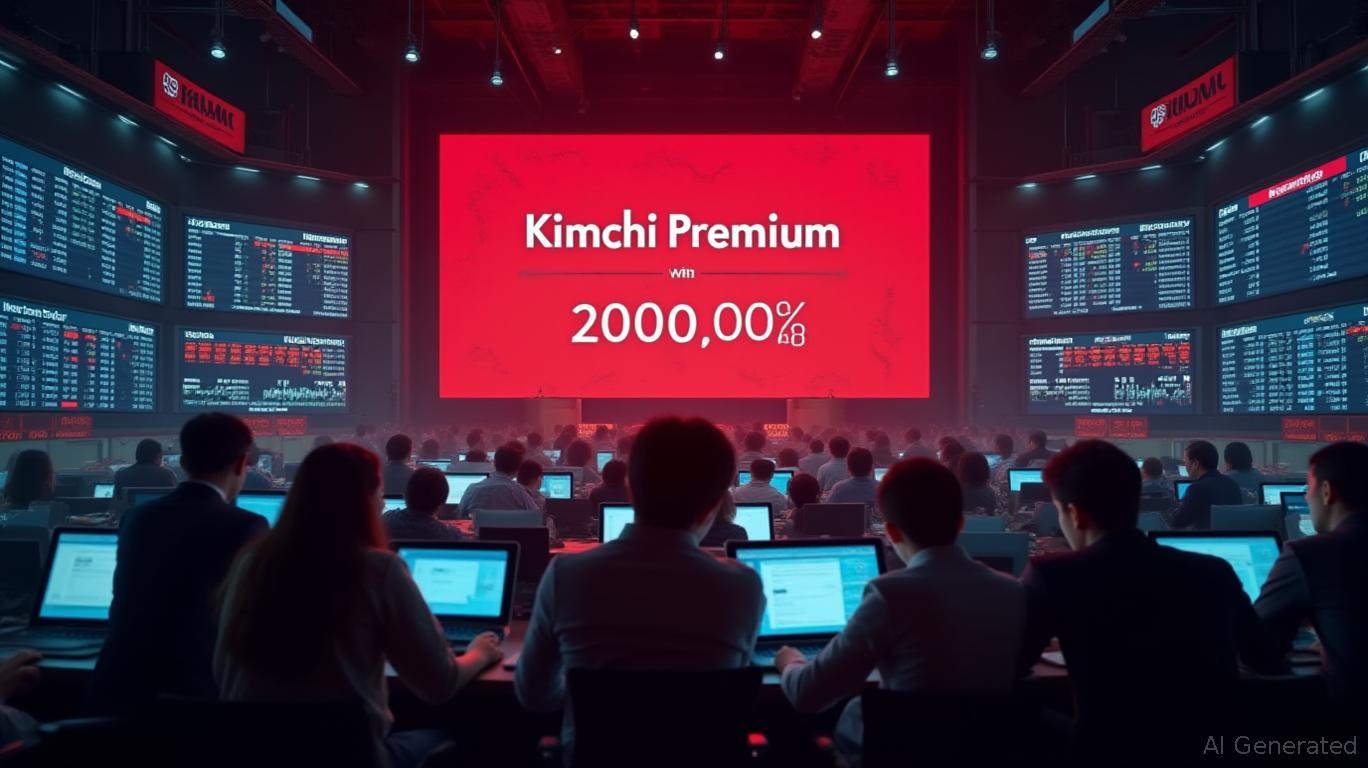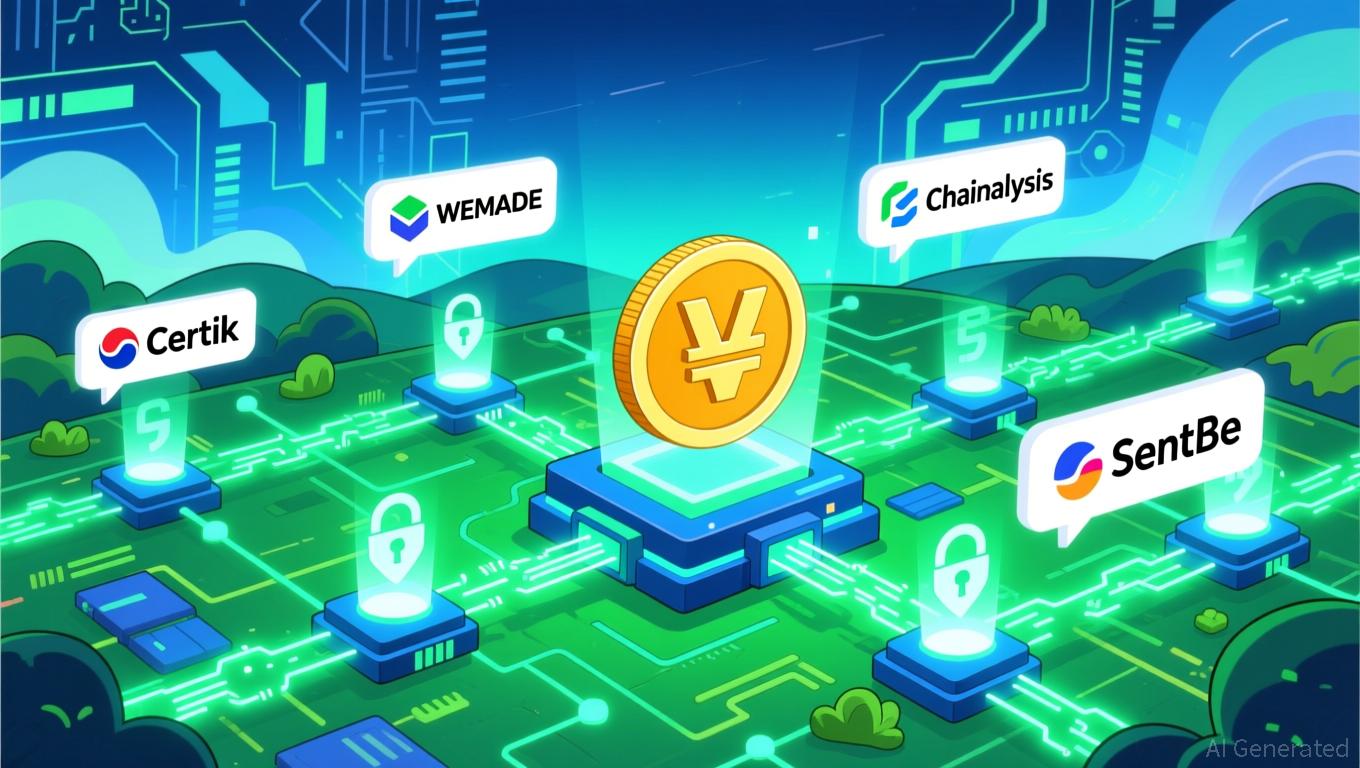Regulatory Challenges Cause Fluctuations in Kimchi Premium for 2025
- South Korea's Kimchi Premium for Bitcoin swung between -3% and +5% in 2025, driven by regulatory shifts and institutional behavior. - Stricter compliance rules and capital controls forced South Korean institutions to reduce crypto holdings, creating temporary oversupply and negative premiums. - Retail investors showed cautious behavior with 22% lower KRW deposits, while won depreciation and travel rules worsened liquidity constraints. - Arbitrage became unprofitable due to 3-4% hidden costs, pushing trad

The Kimchi Premium, a persistent gap in pricing between
The Kimchi Premium originally arose from South Korea’s strict capital controls, which limit the movement of large amounts of Korean won (KRW) abroad. These measures, established after the 1997 financial crisis, restrict arbitrage and foster local price premiums. Yet, during 2024–2025, the premium turned negative for extended periods, reflecting a change in institutional strategies. Local funds and corporations scaled back crypto investments in response to tighter regulations, such as the
Retail investor sentiment also had an impact. Blockchain data showed a 22% drop in KRW deposits to Korean exchanges in July 2025, indicating more cautious trading by individuals amid economic uncertainty and regulatory fatigue Bitcoin Is $2,500 Cheaper in South Korea—What the … [ 2 ]. Additionally, the Korean won’s depreciation against the U.S. dollar in 2024 made Bitcoin more expensive for local buyers, further reducing demand. These factors, along with the introduction of a “travel rule” that requires ID checks for crypto transfers above 1 million won, tightened liquidity even more How to Understand the Kimchi Premium and Its Weird Flip in … [ 1 ].
Traditional arbitrage, once used to profit from the Kimchi Premium, became less attractive as hidden costs mounted. Traders faced combined expenses of 3–4% from trading, transfers, compliance, and currency conversion, making arbitrage worthwhile only when the premium surpassed 5–6% How to Understand the Kimchi Premium and Its Weird Flip in … [ 1 ]. During periods of negative premium, savvy traders shifted away from direct arbitrage, instead engaging in premium momentum strategies—buying when the discount was under 2% and selling when it exceeded 8%. Some companies also used both domestic and offshore entities to work around capital restrictions How to Understand the Kimchi Premium and Its Weird Flip in … [ 1 ].
With the Kimchi Premium fluctuating between -3% and +5% in 2025, it signals an ongoing adjustment in South Korea’s crypto landscape. Positive premiums point to robust local demand and speculative activity, while negative premiums suggest risk aversion among institutions or regulatory concerns. Experts note that the increasing occurrence of negative premiums points to deeper structural changes, such as the introduction of crypto taxes in 2025 and possible relaxation of travel rules for smaller transfers How to Understand the Kimchi Premium and Its Weird Flip in … [ 1 ]. These trends could further align South Korean prices with global markets, reducing the Kimchi Premium’s historical volatility.
For large investors and institutions, the Kimchi Premium acts as a real-time indicator of market mood. A positive premium often reflects capital flowing into Korean exchanges, driven by retail enthusiasm or a search for safety during geopolitical tensions. On the other hand, a negative premium signals capital leaving the local market, especially as institutions reduce exposure. The recent swings in the premium highlight the ongoing push and pull between South Korea’s regulatory environment and the international nature of Bitcoin trading, affecting both liquidity and price formation.
Disclaimer: The content of this article solely reflects the author's opinion and does not represent the platform in any capacity. This article is not intended to serve as a reference for making investment decisions.
You may also like
Korean Won Stablecoin Alliance Seeks to Disrupt US Dollar Dominance in Digital Finance
- WEMADE leads Korean won stablecoin alliance with CertiK, Chainalysis, and SentBe to challenge USD-dominated stablecoin markets. - CertiK provides security infrastructure for StableNet mainnet, while Chainalysis/SentBe enhance compliance and transparency. - South Korea's $10.3B Upbit-Naver merger and KakaoBank's initiatives reflect national strategy to assert monetary sovereignty via blockchain. - Regulatory hurdles persist, but alliance aims to navigate 51% bank ownership rules through security-complianc

Swiss Crypto Tax Postponement Highlights Challenges in International Cooperation
- Switzerland delays Crypto-Asset Reporting Framework (CARF) implementation to 2027 due to stalled international data-sharing negotiations. - The OECD-endorsed framework aims to combat tax evasion via cross-border crypto reporting, with 75 countries participating but uneven global adoption. - Swiss amendments to domestic crypto tax laws include transitional provisions to ease compliance burdens for local firms amid regulatory uncertainty. - Critics warn the delay risks deterring fintech innovation, while s

Strategic Collaborations Between Public and Private Sectors: Driving Real Estate and Industrial Expansion in Underdeveloped Areas
- Public-private partnerships (PPPs) are transforming underserved regions by bridging infrastructure gaps and driving real estate and industrial growth. - Projects like Madrid Nuevo Norte and Costa Rica's affordable housing initiatives demonstrate PPPs' ability to boost property values and create jobs through mixed-use development and public land utilization. - U.S. data reveals racial disparities in PPP benefits, with communities of color experiencing lower baseline home values despite similar growth rate

ICP's 30% Price Jump: Key Factors and What It Means for Web3 Investors
- ICP surged 30% in late 2025 due to upgraded on-chain governance and tokenomics, enhancing decentralized control and utility-driven demand. - Network Nervous System (NNS) reforms simplified neuron activation, boosted developer participation, and introduced periodic voting reaffirmations. - Caffeine AI integration and partnerships with Microsoft/Google drove TVL to $237B, though dApp usage declined 22.4% amid macroeconomic volatility. - Analysts project $11.15–$31.89 price range for 2026, contingent on sus
